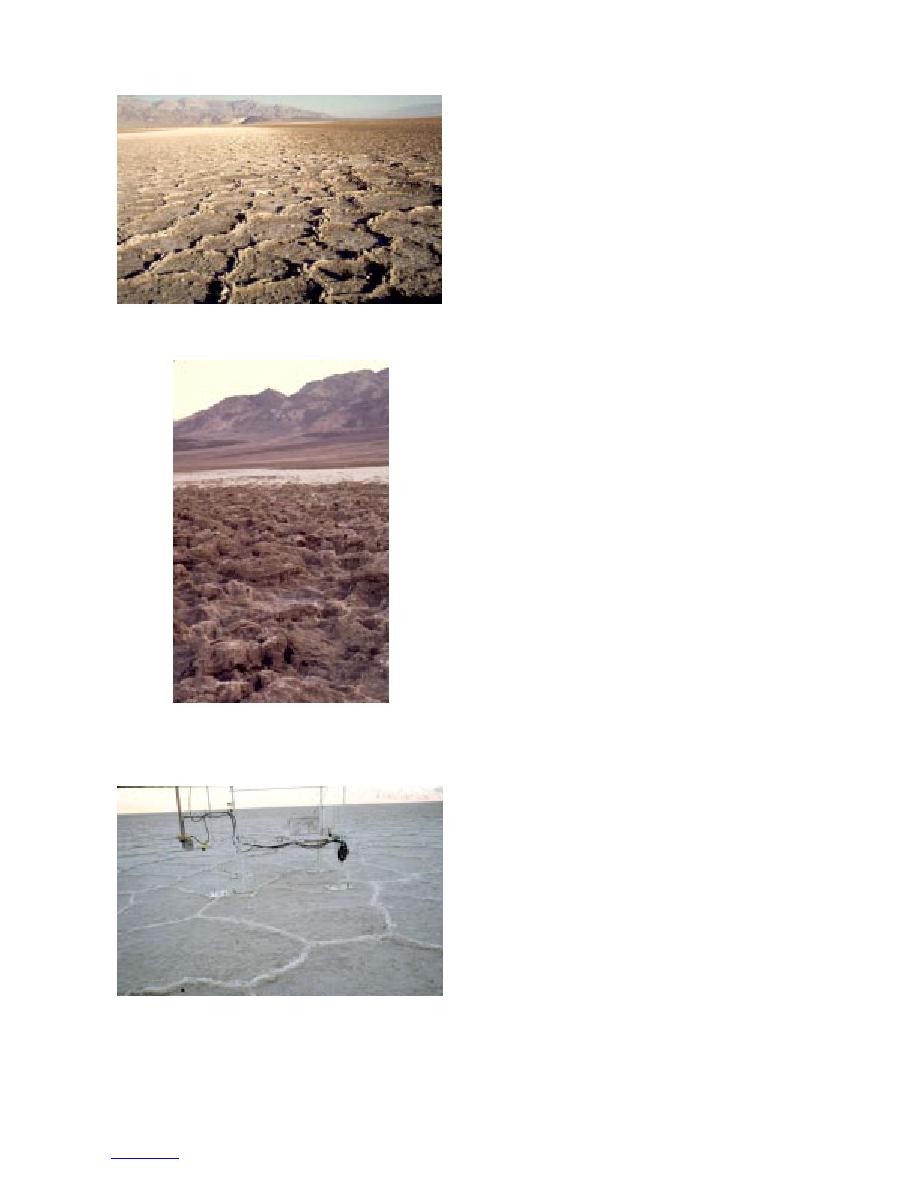
of any such classification system is problematic. Fur-
ther, any one playa may have features of more than one
surficial type (e.g., Neal 1965). Two general sorts of pla-
ya surfaces exist, and several other categories and char-
acteristics may be recognized: One extreme, a hard or
fine-grained playa (Fig. 3) is characterized by having a
dry, compact, generally smooth surface that does not
have groundwater input and which is inundated by rain-
fall and surface runoff (e.g., Stone 1956; Motts 1970,
1972). This type has little microrelief except for surface
crusts, mud cracks, or polygons. The surface sediments
are generally remnant silt and clay deposited during the
a. Soft playa at Death Valley, containing 0.5-m-diam-
Pleistocene when the playas were indeed lakes. In this
eter polygons with upturned edges
type, groundwater is at least several feet removed from
the surface; groundwater depths greater than 5 m (16.4
ft) preclude discharge to the surface and favor the devel-
opment of hard, dry, compact playa crusts with little or
no evaporite accumulation. Consequently, they do not
contain a zone of saturation or a capillary fringe near
the surface because of the depth to groundwater (Motts
1970). Some degree of shine or glaze is also characteris-
tic of these surfaces, related to fine-particle orientation.
Representative playas include Mesquite, Rogers, and
Rosamond, in California.
The other extreme is referred to as a soft or coarse-
grained playa (Fig. 4) and is characterized by a soft, often
moist, friable, puffy surface that develops from capil-
lary input of groundwater and subsequent deposition
of evaporite minerals (Motts 1970, Neal 1972). The sur-
faces of this playa type are loosely compacted and may
be damp to dry during the summer months. Microrelief
may be in the range of 5.087.62 cm (23 in.) or greater,
giving a lumpy appearance. Noticeable swelling may
occur after precipitation, demonstrating the property of
"self-rising" ground (Kerr and Langer 1965). Capillary
b. Soft playa at Death Valley, California, with highly
fringe discharge from groundwater at a depth of 5 m
irregular surface in the foreground and salt crust
(16.4 ft) or less from the surface gives this form its char-
(white area) behind.
acteristic appearance. This type can be converted to
the former by flooding (Motts 1970). In fact, Tyler et al.
(1997) describe a cycling between surface types at
Owens Dry Lake, California. About a quarter of the pla-
yas in California and Nevada are the soft type, about
7% show characteristics of both types (Stone 1956).
Representative soft playas occur at Harper Lake, Cali-
fornia (Neal 1972), and Mesquite Dry Lake, Twentynine
Palms, California (Lichvar and Pringle 1993).
Several surface characteristics, referred to as pat-
terned ground by Hunt (1975), may be evident in the
form of polygons, circles, step-like forms, and stripes.
These surface formations develop as a result of wet-
ting and subsequent drying, thermal changes (diurnal
c. Aspect of soft playa at Death Valley, California. Salt
heating and cooling, freezethaw cycles), or chemical
changes. For Death Valley, Hunt (1975) states that "pat-
is for recording groundwater.)
terned ground" varies in an "orderly fashion that faith-
Figure 4. Aspects of a soft playa.
fully reflects differences in the hydrologic regimen of
7
to contents



 Previous Page
Previous Page
